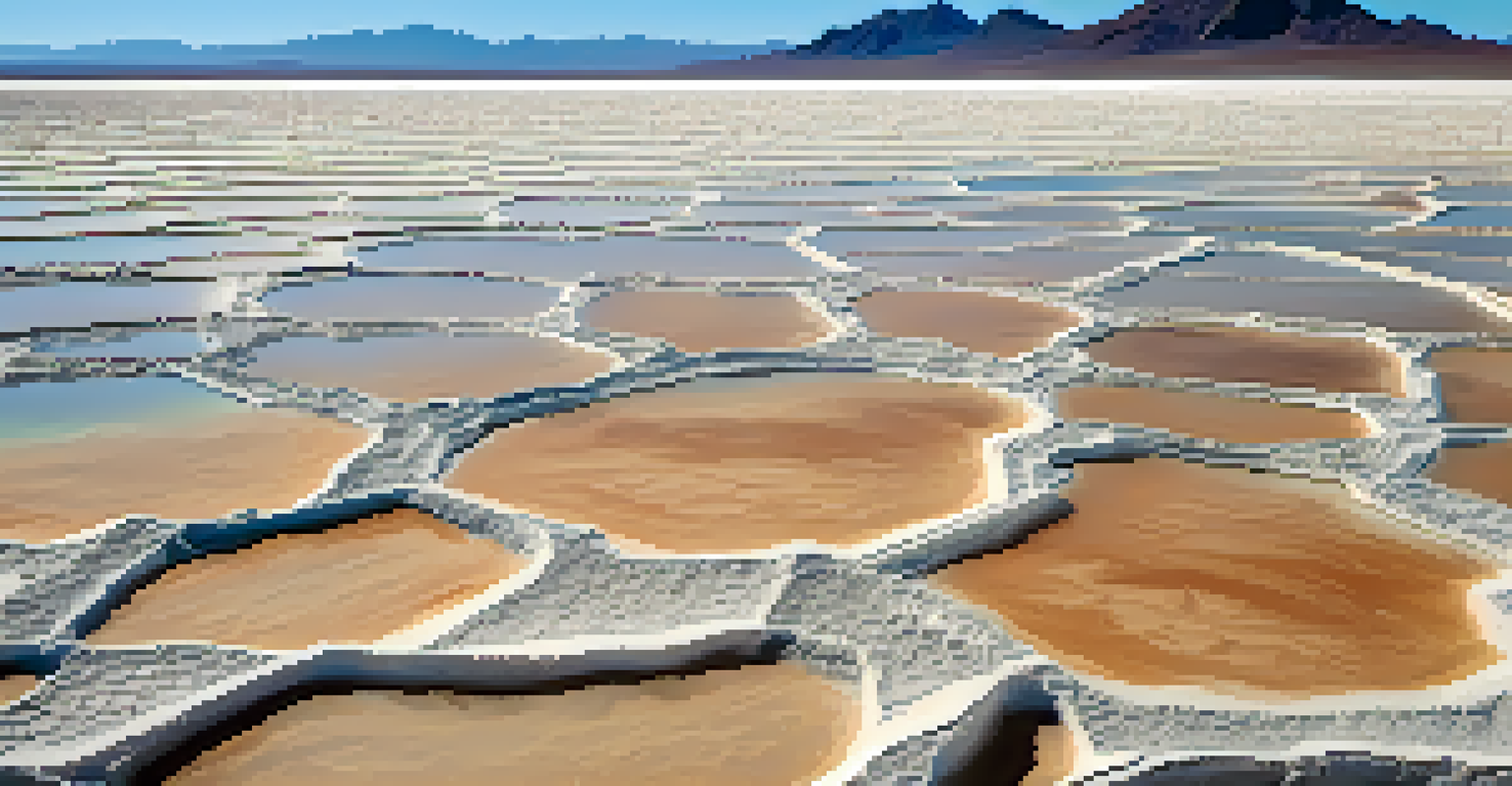The Unique Formation of Salar de Uyuni in Peru

Introduction to Salar de Uyuni: A Natural Wonder
Salar de Uyuni, located in southwestern Bolivia, is celebrated as the world's largest salt flat. While often mistakenly associated with Peru, its stunning beauty has drawn travelers from around the globe. The flat's vast expanse of shimmering white salt creates a mesmerizing landscape that feels almost otherworldly.
Nature always wears the colors of the spirit.
Formed from the evaporation of ancient lakes, Salar de Uyuni is not just a pretty face; it holds a rich geological history. This salt flat is a remnant of Lake Poopó, which dried up thousands of years ago, leaving behind the salt crust we see today. Understanding this process can help us appreciate the complexity and uniqueness of the area.
For many, visiting Salar de Uyuni is a bucket-list experience. From the breathtaking reflections during the rainy season to the stark beauty of the dry season, the salt flat offers a variety of stunning visuals that capture the imagination. Whether you’re a photographer, adventurer, or simply a curious traveler, Salar de Uyuni has something to offer everyone.
The Geological Formation of Salar de Uyuni
The formation of Salar de Uyuni is a fascinating tale of geological processes. It began millions of years ago when tectonic activity led to the creation of large basins in the Andes Mountains. Over time, these basins filled with water, creating massive lakes that eventually dried up, leaving behind salt flats.

During the Pleistocene Epoch, around 30,000 to 12,000 years ago, the region experienced significant climatic changes. These shifts led to the evaporation of large bodies of water, which concentrated minerals and created the salt crust we see today. The unique geology of the area, including volcanic activity, contributed to the rich mineral content found in the salt flat.
Salar de Uyuni: A Geological Marvel
Salar de Uyuni is the world's largest salt flat, formed from ancient lakes and shaped by significant geological processes over millions of years.
The salt crust is approximately 10,582 square kilometers, making it a significant geological feature. As rainwater collects on the surface, it creates a natural mirror effect that attracts many visitors. This captivating phenomenon is a reminder of the natural processes that shaped this remarkable landscape.
The Role of Climate in Shaping Salar de Uyuni
Climate plays a crucial role in the formation and maintenance of Salar de Uyuni. The region experiences a high-altitude desert climate, characterized by extreme temperature fluctuations and minimal rainfall. These conditions are essential for the evaporation process that creates the salt crust.
The Earth has music for those who listen.
During the wet season, typically from December to March, the flat transforms into a stunning mirror, reflecting the sky and surrounding mountains. This natural spectacle is not only a visual delight but also a vital part of the area's ecosystem. The temporary water layer creates a habitat for various bird species, including flamingos, which thrive in this unique environment.
In contrast, the dry season reveals a stark, beautiful expanse of white salt. The cracks that form in the crust during this time create a captivating pattern that photographers love to capture. This duality showcases how climate intricately shapes the landscape, offering different experiences throughout the year.
The Unique Ecosystem of Salar de Uyuni
Despite its seemingly barren appearance, Salar de Uyuni supports a surprising array of life. The salt flat is home to a diverse ecosystem, including various bird species, microorganisms, and plant life. These organisms have adapted to thrive in extreme conditions, showcasing nature's resilience.
Flamingos are one of the most iconic species found in the area, particularly during the wet season. They flock to the salt flats in search of algae and brine flies, which are abundant in the shallow waters. This vibrant splash of color against the white backdrop is a sight that delights visitors.
Climate Shapes Unique Ecosystem
The extreme climate of the region creates a unique ecosystem that supports diverse wildlife, including flamingos and microorganisms, which thrive in its harsh conditions.
Microbial communities also play a vital role in the ecosystem, forming mats that contribute to the salt flat's overall health. These microorganisms help break down organic matter and recycle nutrients, supporting the delicate balance of life in this unique environment. Understanding this ecosystem highlights the interconnectedness of all living things.
Cultural Significance of Salar de Uyuni
Salar de Uyuni is not only a geological marvel but also holds cultural significance for local communities. The indigenous people of the region, including the Aymara and Quechua, have a deep connection to the land that has been passed down through generations. Their traditions and lifestyles are intricately tied to the salt flat and its resources.
The salt harvested from Salar de Uyuni is a valuable resource for local economies. It is used for various purposes, from cooking to industrial applications. This economic reliance on the salt flat has fostered a sense of stewardship among local communities, who work to preserve its natural beauty.
Additionally, the area is rich in folklore and history, with stories of ancient civilizations and mythical creatures. These narratives add depth to the visitor experience, as travelers can appreciate not just the natural beauty but also the cultural heritage of the region. Engaging with local traditions enriches the journey and fosters respect for the land.
Tourism and Its Impact on Salar de Uyuni
Tourism has become a significant part of Salar de Uyuni's identity, attracting hundreds of thousands of visitors each year. Travelers come to witness the breathtaking landscapes and experience the unique ecosystem firsthand. However, this influx of tourism also raises concerns about environmental sustainability.
While tourism provides economic benefits to local communities, it can also lead to challenges such as litter, habitat disruption, and water shortages. Efforts are being made to promote sustainable tourism practices, encouraging visitors to respect the environment and minimize their impact on the delicate ecosystem.
Cultural Heritage and Sustainability
The salt flat holds cultural significance for local communities, and sustainable tourism practices are essential to protect its beauty and resources for future generations.
Travelers can contribute to sustainability by choosing eco-friendly tours, adhering to local guidelines, and supporting community-based initiatives. By fostering a responsible tourism mindset, we can help ensure that Salar de Uyuni remains a pristine destination for generations to come.
Conclusion: The Enduring Beauty of Salar de Uyuni
In conclusion, Salar de Uyuni is a breathtaking natural wonder shaped by geological processes, climate, and cultural significance. Its unique formation tells a story of resilience and adaptation, both in the natural world and among local communities. Visiting this salt flat offers an opportunity to connect with nature and appreciate its intricate beauty.
As tourism continues to grow, it’s crucial to promote sustainable practices that protect this remarkable landscape. By raising awareness about the environmental challenges faced by Salar de Uyuni, we can encourage responsible behaviors among travelers. This collective effort will help preserve the salt flat for future generations to enjoy.

Ultimately, Salar de Uyuni is more than just a picturesque destination; it’s a testament to the power of nature and the importance of conservation. Whether you’re standing on its shimmering surface or gazing at the stars above, the magic of Salar de Uyuni is sure to leave a lasting impression.